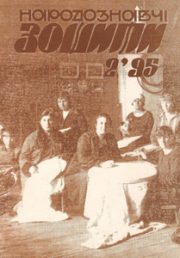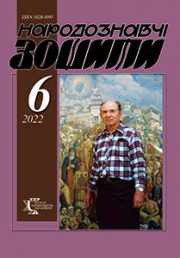The Ethnology Notebooks. 2017, 4 (136), 784–791
UDK 94(477.85/.87). «1938/1939»
DOI https://doi.org/10.15407/nz2017.04.784
Siredchuk Petro Stepanovyh — doctor of historical sciences, professor
Departments of history of slavs Prykarpattya national
to the university of the name of Vasyl Stefanyk
str. Shevchenko, 57, Ivano-Frankivsk, 76000, Ukraine
Contacts: tel. 0342231574
Abstract. It is considering the course of political events, connected with Carpathian Ukraine, at the period from October, 11 1938 to the edge of April 1939. The author highlights different facts of comprehensive support of the process of formation of Transcarpathia Ukrainians statehood by the Galician Hutsulshchyna dwellers. Besides this, the author reveals the Polish state repressive measures against Galician hutsuls coursed to avoid radicalization of their disposition and national resistance movements rising for autonomy and appearance of new Ukrainian statehood at the Western Ukrainian lands, including the territory of Galician Hutsulshchyna.
Keywords: Carpathian Ukraine, Galician hutsuls, Greek Catholic clergy, Polish authority, secret agents, repressions.
Received 10.07.2017
REFERENCES
DAIFO. F. 2. Op. 1. Spr. 2121. Ark. 18 [in Ukrainian].
DAIFO.F. 2. Op. 1. Spr. 2121. Ark. 120–123 [in Ukrainian].
DAIFO. F. 2. Op. 1. Spr. 2328. Ark. 107 zv. [in Ukrainian].
DAIFO. F. 2. Op. 1. Spr. 2328. Ark. 109 [in Ukrainian].
DAIFO. F. 2. Op. 1. Spr. 2328. Ark. 151 [in Ukrainian].
DAIFO. F. 2. Op. 1. Spr. 2328. Ark. 159 zv. [in Ukrainian].
DAIFO. F. 2. Op. 1. Spr. 2328. Ark. 175 zv. [in Ukrainian].
DAIFO. F. 2. Op. 1. Spr. 2328. Ark. 178 [in Ukrainian].
DAIFO. F. 2. Op. 1. Spr. 2328. Ark. 179 [in Ukrainian].
DAIFO. F. 2. Op. 1. Spr. 2328. Ark. 179 zv. [in Ukrainian].
DAIFO. F. 2. Op. 1.Spr. 2328. Ark. 181 zv. [in Ukrainian].
DAIFO. F. 2. Op. 1. Spr. 2328. Ark. 187 zv. [in Ukrainian].
DAIFO. F. 2. Op. 1. Spr. 2328. Ark. 194 [in Ukrainian].
DAIFO. F. 2. Op. 1. Spr. 2328. Ark. 194 zv. [in Ukrainian].
DAIFO. F. 2. Op. 1. Spr. 2328.Ark. 195 [in Ukrainian].
DAIFO. F. 2. Op. 1. Spr. 2328. Ark. 195 zv. [in Ukrainian].
DAIFO. F. 2. Op. 1. Spr. 2328. Ark. 196 [in Ukrainian].
DAIFO. F. 2. Op. 1. Spr. 2343. Ark. 11–11zv. [in Ukrainian].
DAIFO. F. 2. Op. 1. Spr. 2343. Ark. 12 [in Ukrainian].
DAIFO. F. 2. Op. 1. Spr. 2343. Ark. 24 [in Ukrainian].
DAIFO.F. 2. Op. 1. Spr. 343. Ark. 25 zv. [in Ukrainian].
DAIFO. F. 2. Op. 1. Spr. 2343. Ark. 32 [in Ukrainian].
DAIFO. F. 2. Op. 1. Spr. 2343. Ark. 32 zv. [in Ukrainian].
DAIFO. F. 2. Op. 1. Spr. 2343. Ark. 33 [in Ukrainian].
DAIFO. F. 2. Op. 1. Spr. 2343.Ark. 33 zv. [in Ukrainian].
DAIFO. F. 2. Op. 1. Spr. 2343. Ark. 45 zv. [in Ukrainian].
DAIFO. F. 2. Op. 1. Spr. 2343. Ark. 46 zv. [in Ukrainian].
DAIFO. F. 2. Op. 1. Spr. 2343. Ark. 59 [in Ukrainian].
DAIFO. F. 2. Op. 1. Spr. 2343. Ark. 62 [in Ukrainian].
DAIFO. F. 2. Op. 1. Spr. 2343. Ark. 72 [in Ukrainian].
DAIFO. F. 2. Op. 1. Spr. 2343. Ark. 76 [in Ukrainian].
DAIFO. F. 2. Op. 1. Spr. 2343.Ark. 78 [in Ukrainian].
DAIFO. F. 226. Op. 1. Spr. 760. Ark. 2 [in Ukrainian].
DAIFO. F. 226. Op. 1. Spr. 761. Ark. 2 [in Ukrainian].
DAIFO. F. 226. Op. 1. Spr. 793. Ark. 1 [in Ukrainian].
DAIFO. F. 226. Op. 1. Spr. 793. Ark. 2 [in Ukrainian].
DAIFO. F. 226.Op. 1. Spr. 793. Ark. 3 [in Ukrainian].
TsDIA Ukrainy, m. L’viv. F. 179. Op. 5. Spr. 65. Ark. 1 [in Ukrainian].
TsDIA Ukrainy, m. L’viv. F. 179. Op. 5. Spr. 65. Ark. 2 [in Ukrainian].
TsDIA Ukrainy, m. L’viv. F. 179. Op. 5. Spr. 65. Ark. 3 [in Ukrainian].
TsDIA Ukrainy, m. L’viv. F. 214. Op. 1. Spr. 1376. Ark. 6–7 [in Ukrainian].
TsDIA Ukrainy, m. L’viv. F. 214. Op. 1.Spr. 1404. Ark. 31 [in Ukrainian].
TsDIA Ukrainy, m. L’viv. F. 214. Op. 1. Spr. 1405. Ark. 9 [in Ukrainian].
Handziuk, R. (1999). Nadvirna. Istorychnyj narys. Vid najdavnishykh chasiv do nashykh dniv. Ivano-Frankivs’k: Siversiia [in Ukrainian].
Lukaniuk, O. (2017). Roztoky. Istorychnyj narys vid najdavnishykh chasiv do 2016 roku Bozhoho. Kosiv: Pysanyj Kamin’ [in Ukrainian].
Maslianyk, O. (2016). Hutsul’s’ka respublika i Karpats’ka Ukraina v konteksti natsional’novyzvol’nykh zmahan’ ukrains’koho narodu. Hutsul’schyna v plyni vikiv: istoriia i kul’tura: Materialy mizhnarodnoi naukovopraktychnoi konferentsii. Z nahody 25-richchia tovarystva Hutsul’schyna u L’vovi. L’viv, 30 sichnia 2016 r. L’viv: Liha-Pres [in Ukrainian].
Siredzhuk, P. (2011). Diial’nist’ «Prosvity» u Mykulychyni. Mykulychyn.Vyp. 2. Ivano-Frankivs’k: Foliant [in Ukrainian].
Rzemieniuk, F.(2004). Stosunek greckokatolickiego duchowieństwa do państwa polskiego II Rzeczypospolitej (1918–1939).. Rocznik historyczno-archiwalny. Przemyśl. T. XVIII. S. 189–279 [in Polish]..
Rzemieniuk, F.(2003). Walki polityczne greckokatolickie goduchowieństwa o niepodłeglość Ukrainy w okresie II Rzeczy pospolitej (1918–1939). Siedlce [in Polish].






